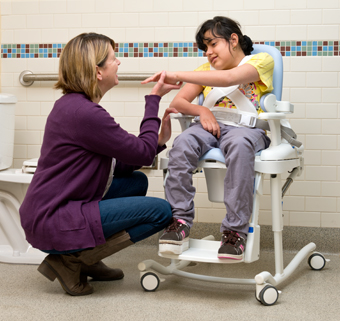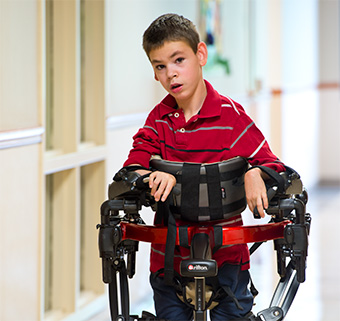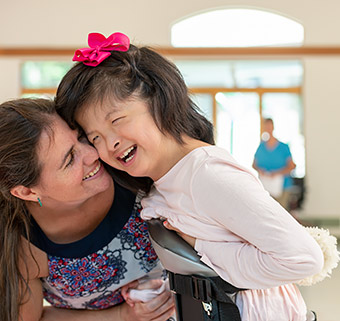Great Strides with the Rifton TRAM
A TBI Success Story
| March 2015A few years ago we welcomed a non-traditional student – we’ll call him Jay – at Lincoln Developmental Center (LDC) where we work. Most of our students have had a development disorder since birth; most are undersized and fit well into traditional equipment, but Jay sustained a traumatic brain injury at the age of 14 and arrived at LDC at the age of 17, fully grown, with limited positioning options. It took two or three staff to transfer him out of his wheelchair and into a Pacer or Advancement Chair. He used the XL Pacer, but it was not tall enough for him to encourage an effective gait pattern. From the MOVE program we know that it may take up to 2,000 trials to learn a new skill, but Jay was not given the opportunities for the needed trials because of the time and effort it took to transfer him. We were also concerned about his safety and ours while lifting him.
|
January 2012 |
|
June 2012 |
Everything changed when we purchased a Rifton TRAM for Jay’s classroom. It took us a while to find the correct adjustments with the walking saddle, but with the help of training materials from Rifton we were able to find the best set up for Jay. He now uses the TRAM for most of the morning and into the afternoon.
|
September 2014 |
|
September 2014 |
|
February 2014 |
|
May 2014 |
He is currently able to transition out of his wheelchair with assist of only one person using a stand pivot transfer to his strong side to a mat table. Standing, he is able to bear his weight when he reaches a certain degree of knee extension (a new skill that has developed only this year). The walking saddle is placed on the mat table so when he sits down it is right where it needs to be. While he is supported by another person on the edge of a mat table, the TRAM is positioned around his trunk and the walking saddle that is positioned under his body is attached to the frame. He typically sits on the edge of the mat table while being supported by the TRAM while other students are getting up and ready for the day. He likes to be able to watch people coming and going from the classroom. Typically then he walks to the office for attendance or to deliver a message, or he stands up and walks over to another part of the classroom for morning opening. Once he gets there, he sits down in a standard chair while the TRAM supports him at the trunk and forearms.
|
October 2014 |
|
October 2014 |
|
October 2014 |
|
October 2014 |
During morning opening, the teacher has the students listen to Alicia Key’s “New Day” on the iPad. Students walk from peer to peer passing the MINI JAMBOX (which is a hand held Bluetooth speaker) to encourage interaction, grasping, holding and reaching out. Jay is able to transition from sit to stand using the TRAM, walk over with assistance to another student, hand them the speaker, and then walk back to his chair to sit down. With the assistance of the TRAM, he is also able to stand up and hold a flag for the pledge of allegiance and return to his seat. Jay has an opportunity during this time to identify which students are in attendance that day, stand up and walk over to greet them or place his picture on the board to show that he is present. He may also walk up to the board to assist with the calendar or to make a choice of which classroom job he may do during the day. All of this occurs within the first 30-45 minutes of the morning activity in the classroom. Within this time, Jay has had the opportunity to transition from sitting to standing 4 or 5 times, pivot transfer 3 or 4 times, walk a short distance of 5 to10 feet 4 or 5 times, and step backward 2 or 3 times.
|
November 2014 |
|
January 2015 |
|
January/February 2015 |
|
February 2015 |
Prior to using the TRAM, he may have been sitting in his wheelchair, feederseat or a large Advancement Chair during the entire activity. And half the time he wouldn’t have even attended because he was less active and engaged.
Without a doubt the TRAM has improved Jay’s quality of life. He is now an active participant in his class. He is closing in on the 2,000 trials in multiple areas of motor skills. He engages with peers and staff by lifting up his head and reaching out. He is more consistent in activating a switch for choice making. He is now stepping more consistently and he is assisting during transitions from sitting to standing with and without the support of the TRAM. The TRAM has eliminated the need to lift him into equipment, which has increased his opportunities to move, resulting in an increase in functional skills. Every time Jay figures out a new skill the look of accomplishment and pride on his face is priceless.
|
February 4, 2015 |
|
February 19, 2015 |
|
February 19, 2015 |





















